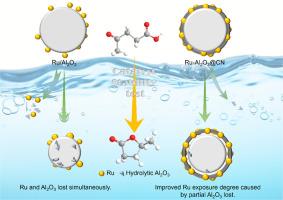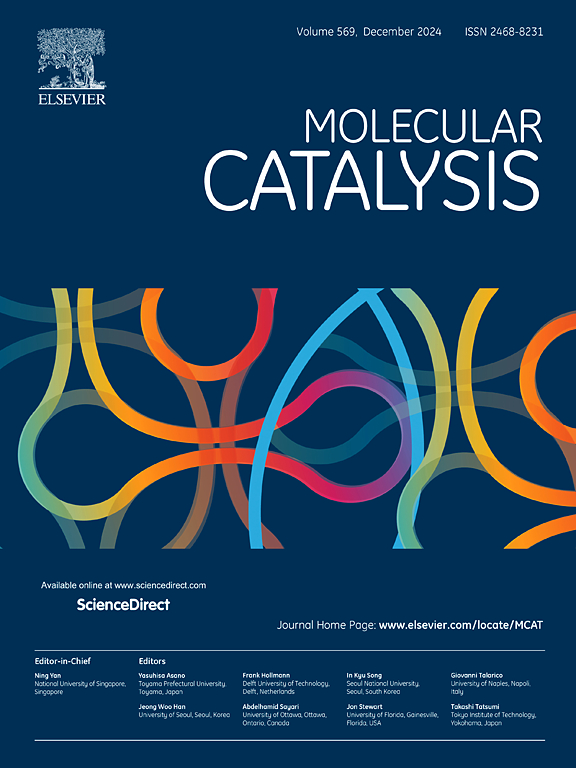Enhanced hydrothermal stability by a semi-embedded structure: An efficient Ru catalyst for levulinic acid conversion in the aqueous phase
IF 3.9
2区 化学
Q2 CHEMISTRY, PHYSICAL
引用次数: 0
Abstract
Catalyst stability is believed to be one of the greatest challenges faced for the supported metal catalysts in the catalytic conversion of biomass and its derivatives because many biomass transformations are conducted in the aqueous phase. In this work, we report a simple yet efficient coating-impregnation-pyrolysis (CIP) strategy to fabricate Al2O3 supported Ru catalyst (Ru-Al2O3@CN) with Ru NPs (nanoparticles) semi-embedded into N-doped carbon (CN) layer for the efficient hydrogenation of levulinic acid (LA) to γ-valerolactone in the aqueous phase. Benefit from the special structure of Ru-Al2O3@CN catalyst, it possesses both high catalytic activity and stability, giving a TOF of 28,099 h-1 for LA hydrogenation at 120 °C and 2 MPa H2, which is superior to the most of reported Ru-based catalysts. More importantly, compared with conventional impregnated Ru/Al2O3 catalyst, the Ru-Al2O3@CN catalyst exhibits a remarkably improved hydrothermal stability. Based on series of catalyst characterizations and control experiments, it was found that the presence of CN can weak the interaction between Ru and Al2O3, as well as protect the Al2O3 and Ru NPs from hydrolysis and aggregation, respectively. We anticipate that such a novel strategy may provide some valuable insights into the synthesis of oxides-supported metal catalyst with high hydrothermal stability.

半嵌入式结构增强了水热稳定性:一种用于水相中乙酰丙酸转化的高效 Ru 催化剂
在生物质及其衍生物的催化转化过程中,催化剂的稳定性被认为是支撑金属催化剂面临的最大挑战之一,因为许多生物质转化都是在水相中进行的。在这项工作中,我们报告了一种简单而高效的涂层-浸渍-热解(CIP)策略,用于制备 Al2O3 支持的 Ru 催化剂(Ru-Al2O3@CN),其 Ru NPs(纳米颗粒)半嵌入 N 掺杂碳(CN)层中,用于在水相中高效氢化乙酰丙酸(LA)至γ-戊内酯。得益于 Ru-Al2O3@CN 催化剂的特殊结构,它同时具有高催化活性和稳定性,在 120 °C 和 2 MPa H2 条件下,LA 加氢的 TOF 为 28,099 h-1,优于大多数已报道的 Ru 基催化剂。更重要的是,与传统的浸渍 Ru/Al2O3 催化剂相比,Ru-Al2O3@CN 催化剂的水热稳定性显著提高。根据一系列催化剂表征和对照实验,我们发现 CN 的存在可以减弱 Ru 和 Al2O3 之间的相互作用,并分别保护 Al2O3 和 Ru NPs 免受水解和聚集。我们预计,这种新颖的策略可能会为合成具有高水热稳定性的氧化物支撑金属催化剂提供一些有价值的见解。
本文章由计算机程序翻译,如有差异,请以英文原文为准。
求助全文
约1分钟内获得全文
求助全文
来源期刊

Molecular Catalysis
Chemical Engineering-Process Chemistry and Technology
CiteScore
6.90
自引率
10.90%
发文量
700
审稿时长
40 days
期刊介绍:
Molecular Catalysis publishes full papers that are original, rigorous, and scholarly contributions examining the molecular and atomic aspects of catalytic activation and reaction mechanisms. The fields covered are:
Heterogeneous catalysis including immobilized molecular catalysts
Homogeneous catalysis including organocatalysis, organometallic catalysis and biocatalysis
Photo- and electrochemistry
Theoretical aspects of catalysis analyzed by computational methods
 求助内容:
求助内容: 应助结果提醒方式:
应助结果提醒方式:


